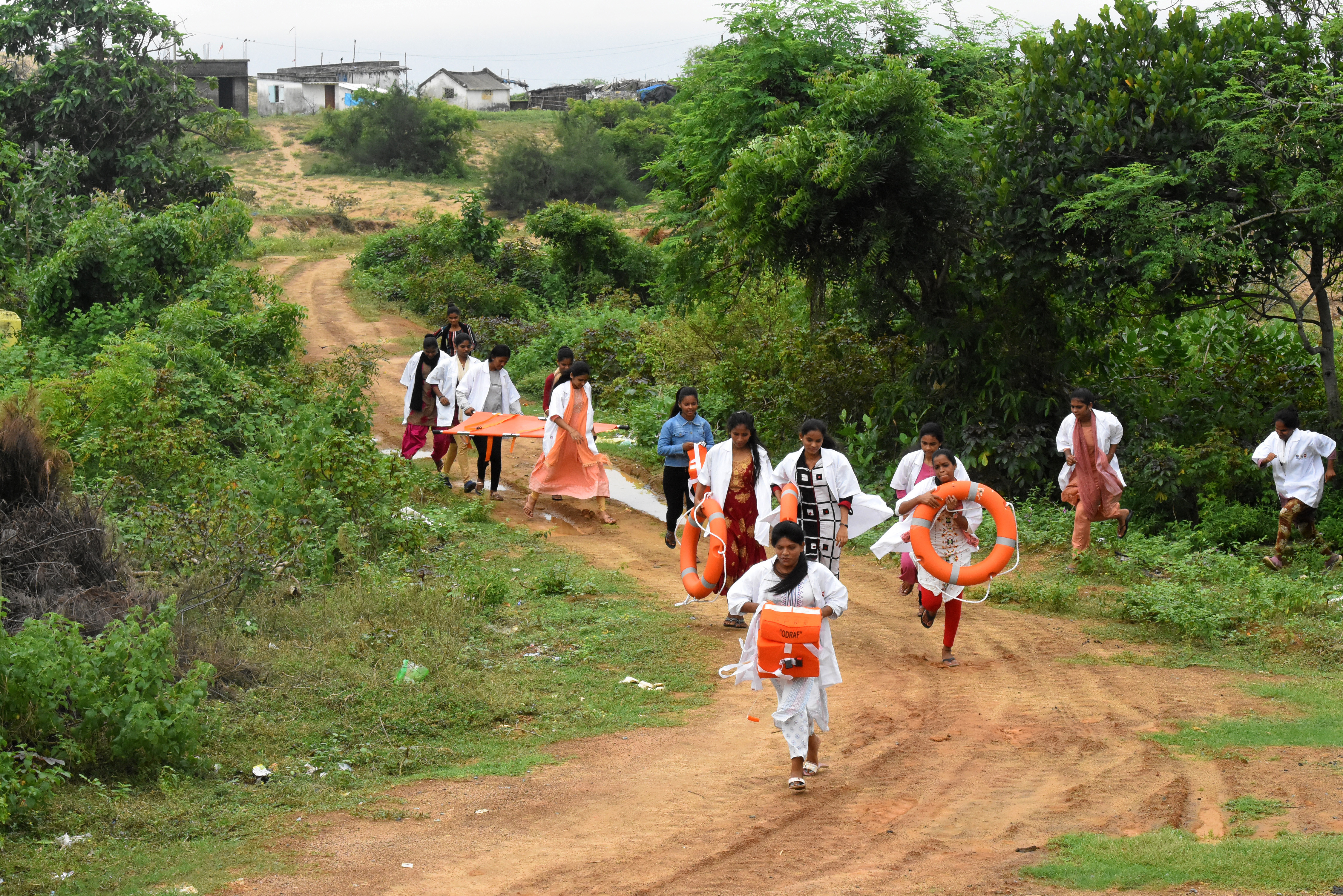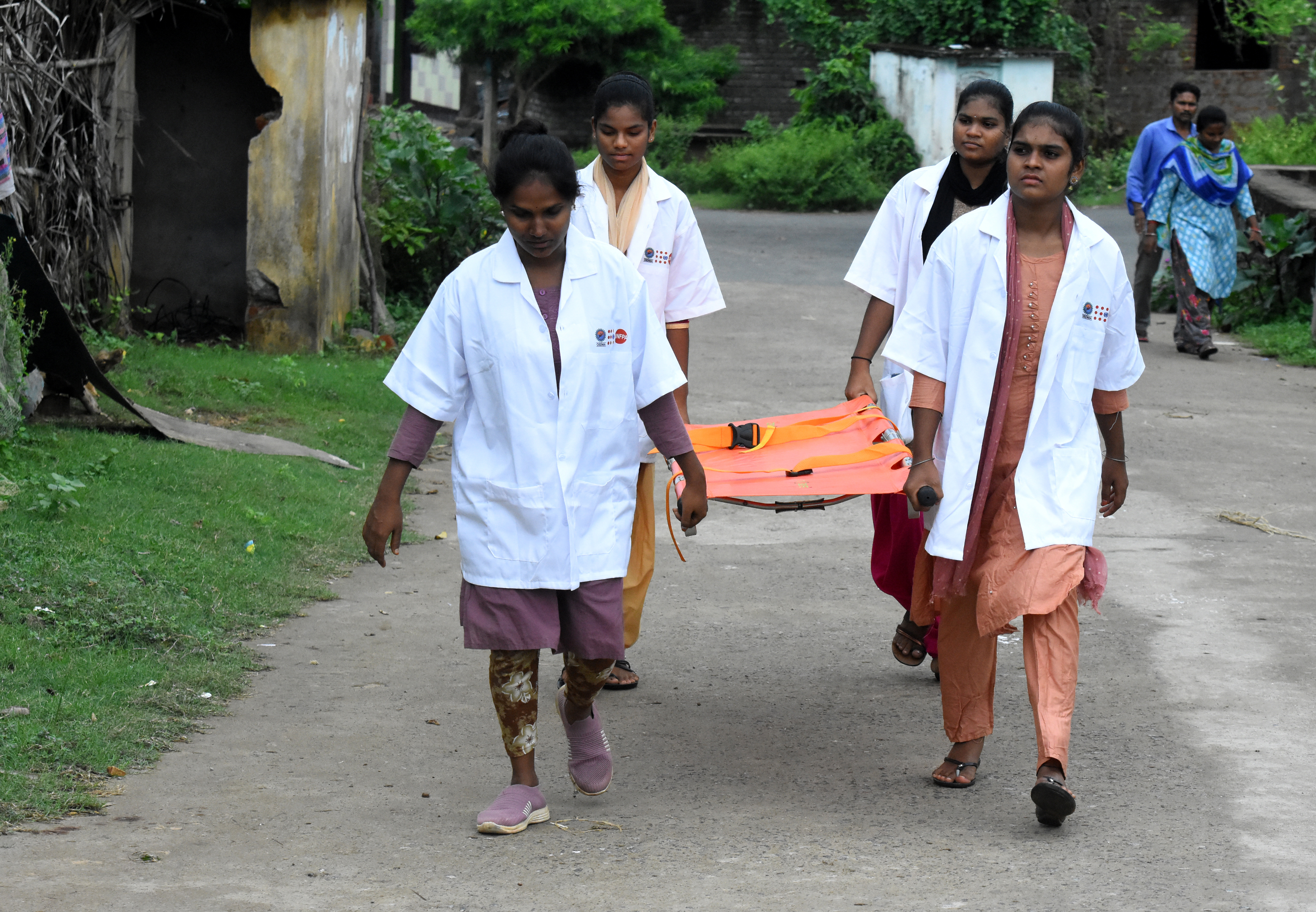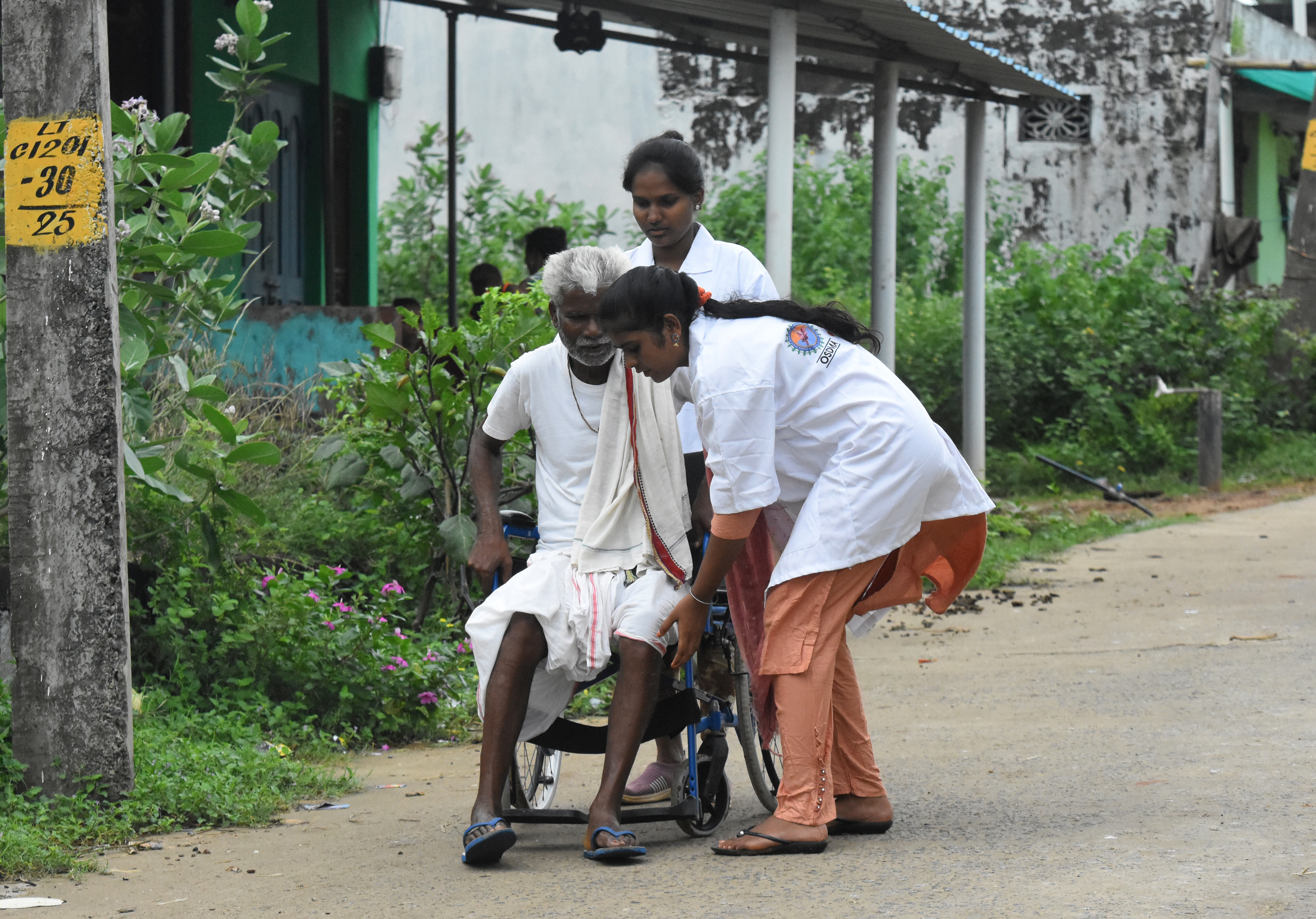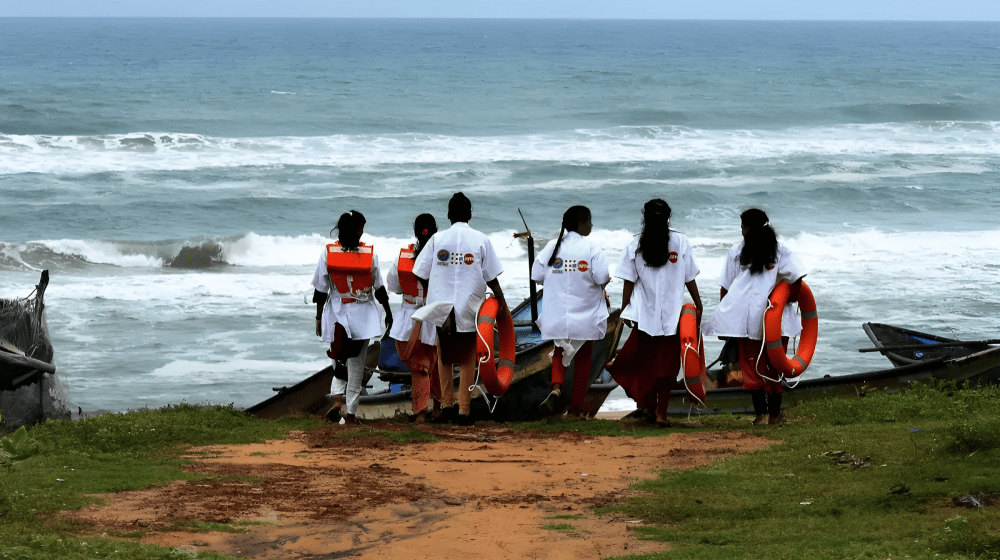As published on Outlook, authored by Bijoy Patro
A few decades ago, Gyana Ranjan Das, the managing director of the Odisha State Disaster Management Authority (OSDMA), happened to witness a saree-clad village woman carrying a well-built man on her shoulder from atop a cyclone shelter down a ladder during a cyclone preparedness drill in the state. In another instance, he was accompanying a visiting foreign dignitary to witness a preparation drill. Young men crossing a pond had to balance themselves over a single rope with another parallel rope for support. It was meant to simulate a flood situation, the rope serving as a bridge. “One after the other, the young village boys fell into the pond. At last, it was a young girl who volunteered to demonstrate how to cross the pond without falling,” he recalls.
These incidents left Das impressed by the grit, strength and stamina of the girls and women of villages in Odisha. It is tough to go up with a person on your shoulders, but it is even tougher to come down with that load, he points out, referring to the first incident. In the second instance, he found the village girls’ courage commendable.
Field observations such as these prompted the OSDMA to consider mobilising women and training them in disaster management skills, besides strengthening the key skills of critical thinking, creativity, communication and decision-making, thereby empowering them in general. After all, not only would they need these skills to protect themselves but also the people around them in times of emergencies. “It was also a learning process. The presumption is that men are physically stronger and more confident. Those mental barriers must be broken at some point in time,” says Das. Such mental barriers about gendered roles and notions abound today.
While activities related to disaster preparedness have been conducted for years now, in 2022, the OSDMA partnered with the United Nations Population Fund (UNFPA) to integrate and strengthen the gender transformative approach in risk reduction via a pilot project, mainstreaming gender in disaster risk reduction to provide training to young women from five coastal villages—New Baxipalli, Baxipalli village, Venkatraipur, Deegipur and Dharampur—in the southern district of Ganjam in Odisha. The training involves survival skills and emergency search and rescue and first aid, besides soft skills like teamwork, combating gender-based violence, providing psycho-social care and speaking confidently with strangers.

Besides this initiative on training, the approach also visits matters of policy that entail strengthening the gender components in the state and the district disaster management plans. It also involves undertaking the formulation of a policy document on the establishment of a gender cell at the OSDMA.
Other components of the approach include conducting training for stakeholders like panchayat members, ASHA and anganwadi workers, besides others on issues of gender in risk reduction. Community resilience is also enhanced by introducing an identified cadre of young girls as first responders on early warning, search and rescue and first aid.
The five villages were chosen to further an example of the strategy on community resilience while keeping in mind their social and economic milieu. They are inhabited by fishing communities, which depend entirely on the sea for their livelihood as the land is not arable. The months of May–June and October–November, marked by cyclones, are particularly troublesome for the residents. It is also when the menfolk are not around as they head for work towards Andhra Pradesh, Tamil Nadu, Kerala, Goa or Maharashtra early in May and return in December.

Most able-bodied males go to catch fish and bring home money; however, many take a break to work as construction labourers in big cities. So, the women, elders and children are left to fend for themselves when the sea in the Bay of Bengal gets violent. “The men are not here in the cyclone season, usually in May and October,” says M Vasudev Rao, the secretary of a cyclone shelter. “They would be here if they had land to till. Nobody here practises agriculture because they have the sea to farm,” he adds. Thus, during these months, it is the women of the village who largely shoulder the burden of dealing with disasters, making it important for them to have the necessary life skills.
Burdened by Stereotypes
There was a lot of optimism around training women, but there was no dearth of dissenting voices either. People argued that girls would get married and leave the village someday, Das recalls. His counter argument then was that the knowledge would help these girls wherever they went, and it did not matter whether they lived within or outside the village. “Leaving the village is not the fate of girls alone,” he told them, pointing out that young men too leave the village in search of jobs. Thus began a series of training programme for women. However, getting them to volunteer was important, especially for challenging tasks like rescuing pregnant women, among others.
Going forward, specific needs of women need to be taken into account inside cyclone shelters. For instance, toilets need to be made women-friendly. Bins would be useful for menstruating women for disposing of used sanitary napkins. A woman undergoing a miscarriage at the shelter needs attention for her mental and physical condition. Pregnant women need more frequent meals than twice a day as are provided currently at cyclone shelters.
Working Towards an Empowered Future
What Das realised over two decades ago remains the leitmotif of the OSDMA-UNFPA action plan as the project also looks at violence against women, realising that brutalities and marginalisation do not come from nowhere but reflect the “norm” in women’s lives and recognising that prevention must begin long before an emergency happens.
The pilot project for mainstreaming gender in disaster risk reduction gave birth to the gender and inclusion cell at the OSDMA, which will eventually be headed by an officer from the administrative services who will work with an advisory board. At a later stage, this will enable policy formulation. Framing a gender and inclusion policy will also support the implementation of the national and state disaster management plans and contribute to the achievement of the Sustainable Development Goals.

Recognising Women as Disaster Responders
The nature of the impact of a disaster varies from men to women and from boys to girls. The coping capacity of boys and men is different from that of women and girls. While the OSDMA and the government of Odisha have consistently maintained high standards in disaster management, the integration of inclusivity and gender into disaster risk reduction has remained a longstanding goal.
India’s revised National Disaster Management Plan (NDMP) of 2019 emphasises on social inclusion, particularly gender, as a ubiquitous and cross-cutting principle. It requires that women be actively involved in the planning and implementation process in disaster situations, thus contributing to building resilience. The plan also emphasises on the need to account for marginalised gender groups during the implementation to ensure their concerns are addressed.
The prime minister’s 10-point agenda for disaster risk reduction also emphasises on greater involvement of women in risk reduction. Both the revised NDMP and the prime minister’s 10-point agenda on risk reduction have paved the way for gender to be integrated into states’ disaster management plans with a more strategic approach. Taking the lead, the OSDMA has begun strategising for comprehensive involvement of women in its programmes.
Fixing the Nuts and Bolts of Inclusion
Pushing for inclusion requires strengthening data management and using data to support gender-sensitive approaches. This is the basis for enabling the convergence of concerned government departments to ensure gender sensitivity in disaster risk reduction. It also involves a review of existing regulations, norms and directives, and revising them to make them gender-sensitive. Additionally, OSDMA will focus on vocational training and skill development schemes targeted at women. Most importantly, a curriculum, which seeks to empower women to assume leadership roles, is being developed. Interestingly, OSDMA is also gearing up to conduct gender audits of disaster risk mitigation measures with assistance from the state women’s commission.
But how does it work on the ground?
Adopting a gender-sensitive approach in all disaster risk reduction programmes helps build women’s capacities and resources, thus empowering them. Gender mainstreaming in risk reduction is inter-linked with the induction of disaster reduction into the government’s sustainable development policies.
On the ground, OSDMA and UNFPA are now working with young women, most of them adolescents, training them to handle disaster situations when required. “While these will make it easier for women to support themselves, the intention is to build their capacities to use the golden hour. It is the first hour after a cyclone warning has been sounded that can make a life-and-death difference,” says Aranyak Mishra, UNFPA-OSDMA’s programme officer in charge of the gender transformative project.
“Women, with their extensive knowledge of communities, social roles of managing natural environmental resources and caring responsibilities, increasingly play a critical role in disaster risk management,” says Mishra. “Empowering them is the key to strengthening disaster resilience of communities,” he adds.
Mainstreaming Gender in Disaster Risk Reduction
Addressing gender issues in disaster risk reduction requires more attention to the status of women, along with the challenges they face, Mishra avers. He couches his explanation in the lower incidence of ownership of assets and property by women and the fact that they have fewer decision-making opportunities within the family. Even when they work outside, they do not get paid as much as the men, he notes.
The women are less skilled and have fewer opportunities to develop skills and are socially and economically weaker than men. Being unequal to their male counterparts means they hold a lower status within their communities. The socially subordinated position of women compounds their vulnerability across all categories, and they are often dominated by male members of the family.
Gender-based inequalities and vulnerabilities place women at greater degrees of risk to disasters. Disaster situations, with the breakdown of family, community and institutional security and protection, generally make prevailing gender-based disparities surface to a greater degree than in normal situations, putting already vulnerable groups at higher risk, Mishra says, stressing that the objective of the pilot project is to keep women and girls at the centre of risk reduction plans. He explains how boys in the fisher community are trained by their fathers and uncles in negotiating the ways of the sea. They are groomed to eventually become fishermen. These life-saving skills are the ones that their community requires in the face of a cyclone. In contrast, the girls in the community are not taught even to swim. “It is inherently gender driven,” Mishra says.
Discrimination against women in disaster settings can be life-threatening and requires attention through all phases of humanitarian interventions. The gaps that the OSDMA and the UNFPA have identified are not insurmountable. Muhammad Nadeem Noor, who heads UNFPA’s Bhubaneswar office, says that the partnership between OSDMA and UNFPA brings to the table a refreshing reconsideration of the ways to take note of discrimination against women and reconceptualise and articulate these in accordance with global standards of human rights and gender justice.
The leadership at OSDMA realises that gender equality and inclusion are crucial to building a disaster resilient society and this can be accomplished only through equality of access to resources and inclusive decision making, planning and implementation of programmes, projects and activities. The state’s leading disaster management body recognises that the path towards strengthening gender equality must also necessarily take into account gender diversity and intersectionality, i.e., inequalities resulting from all other forms of embedded discrimination.
OSDMA is now aiming for a gender-sensitive approach to disaster management and building risk resilience. A “Gender and Inclusion Policy” in the making will guide and steer a process, which will support the Sustainable Development Goals and National and State Disaster Management Plans, while building a disaster resilient Odisha.
It recognises that it is crucial to address underlying vulnerabilities and their root causes for building long-term and sustainable resilience. OSDMA realises that women and sexual minorities, who are among the most vulnerable, should not be seen as mere beneficiaries but as partners with recognised and mandated spaces at all levels, including governance, policy formulation, project planning and monitoring from state to village.
The OSDMA is going big on gender equity in disaster management. The inclusion of women and harnessing the immense potential that they hold in boosting the state’s disaster risk reduction activities remain the eventual goal. The objective of the pilot project for mainstreaming gender in disaster risk reduction is to keep women and girls at the centre of risk reduction plans.
Girls Take Charge
Seventeen-year-old K Neelaveni is besotted with Telugu film actor, producer and entrepreneur Ram Charan. She has watched his movie Orange over 30 times, she says proudly. “Call me R.C. Neela,” she insists, eager to make her own association with the actor. A year ago, Neelaveni would have been unrecognisable, being the shy and hesitant girl that she was back then. Today, she comes across as a confident and outspoken girl due to her engagement with the UNFPA team.
Her village, Baxipalli, abuts the sea. That is where her father goes out daily with his group of four in a small dingy boat. He sells his catch in the villages farther away from the sea. When this reporter met Neelaveni, her father’s group had left for Kerala, while other able-bodied males had left for Tamil Nadu, Andhra Pradesh or Maharashtra in search of work.
“I now know that to be able to save others, I need to first care for myself. I need to save myself,” Neelaveni says, matter-of-factly, with an expression that speaks volumes of the determination to be helpful to herself and her community.
Her friend, 19-year-old Janangi Soni, echoes a similar sentiment. “Now we know how to help others. We will not be able to achieve anything if we cower. We girls need this training. This has helped all girls to come out of their limitations,” she says.
Soni points out that the girls never left home earlier. However, when they started going for trainings, she met girls from the neighbouring village whom she had never met earlier.
Each one of the girls this reporter spoke with admitted that they lacked the confidence to speak to an outsider earlier. Following the training, they have not only become confident but can also talk to outsiders, which, they realise, will be a prerequisite when they are on search-and-rescue missions.
The village sarpanch, A Narasimhulu, a retired army man, says the young volunteers’ enthusiasm reflects a refreshing change from the conventional mindset of the villagers. “Earlier, I used to think that the women were hesitant to come out. But I can see how training has given the girls the confidence that they too can do what boys can. It has also improved their stamina,” he says.


